| Title Welcome to the Neighborhood of Rattlesnakes | |
|
Author Christopher Cavalli American River College, Geography 350: Data Acquisition in GIS; Spring 2004 | |
|
Abstract Though it has been a resident for many, many years in the foothills of Yuba, Placer, and Nevada counties, the Northern Pacific rattlesnake is no longer free to roam through the territories of its ancestors. The gold rush for land has brought the human presence directly into the heart of its land. Beautiful homes appearing in the midst of the countryside bring families and their pets into the rattlesnakes' domain. Conflict between man and snake has proven to be inevitable. Snakebite must be treated in a medical facility where antivenin can be given within the optimum time period of 6 hours from the envenomation. Many times this requires that the victim be airlifted to hospitals and trauma centers prepared to treat rattlesnake bites. But without extensive research and data gathering of the locations of the attacks, reason for the attack, and other key factors, the ability to prepare for future snakebite victims seems to be inadequate at best. Factoring in the deadly potential of envenomation by a rattlesnake, the need for effective planning is crucial and critical to human lives. | |
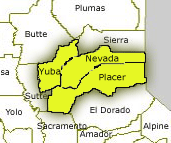
|
Introduction Throughout the rolling, rugged hills of eastern Placer, Nevada, and Yuba Counties, this once sparsely populated hill country is now experiencing an unprecedented rush of new homeowners fleeing the congestion of the Sacramento Valley. This land, however, has been the home of many native animals long before it became a beautiful place to build a home. Some of these creatures are learning to adapt well to the human inundation, others are not suited to such adaptation. One of these non-conformists, the Northern Pacific Rattlesnake, does not fear the confrontation with humans. It is the human who must fear and respect the rattlesnake. |
|
In Northern California, the Northern Pacific rattlesnake is the only native venomous species. Their territory ranges from west of the Rockies south to San Luis Obispo. Their temperament can range from inoffensive to easily provoked. If threatened, the rattlesnake may coil, rattle, and raise its upper body, appearing ready to strike while actually backing slowly away with its lower body. However, if surprised, it may lunge up to several feet, striking without any warning behavior whatsoever.
When bitten, the person or animal must seek medical attention immediately. Though some strikes may not deliver venom (dry bites), all snakebite victims should assume that venom was injected. There are several trauma centers that serve the three counties for rattlesnake bites: Sierra Nevada Memorial Hospital in Grass Valley, Sutter Roseville Hospital in Roseville, and Auburn Faith Hospital in Auburn. The prescription item CroFab antivenin is used for the treatment of rattlesnake envenomation and it must be administered by a medical facility. The typical snakebite can require up to 10 vials of antivenin for treatment. At $1000 a vial and 3 to 4 days of hospitalization, treatment can be costly. Unfortunately, snakebite information is not readily available, even from the trauma centers mentioned above. Another factor for concern is that the availability of antivenin which has been in short supply for the last several years. With the increasing numbers of homes being built in the heart of rattlesnake country, the confrontation between man and snake could easily escalate. Unless greater preparation for future needs is made, the treatment of rattlesnake envenomation could take a deadly turn. | |
|
Background General Information Of the estimated 45,000 snakebites each year in the United States, approximately 8,000 involve venomous species. However, the California Poison Control Center notes that rattlesnakes only account for about 800 of those bites each year with about one to two deaths. California rattlesnake species include the Northern Pacific Rattlesnake in Northern California, and in Southern California the Western Diamondback, Sidewinder, Speckled rattlesnake, Red Diamond rattlesnake, Southern Pacific, Great Basin rattlesnake and the Mojave rattlesnake. Rattlesnakes belong to a group known as pit vipers. They get this title due their highly specialized venom apparatus which include two long hinged fangs and a pair of extremely sensitive innervated pits which are located between their eyes and nostrils. These pits are "heat detectors" used for hunting which are so sensitive that blindfolded snakes have been able to accurately follow warm-blooded prey (e.g., rodents) from a distance of 6 feet. Without the blindfold, rattlers have good vision to at least 15 feet away under moderate illumination and are equipped for day and night vision. The eyes are set so far to the sides of the head that they have only a limited field of binocular (stereo) vision. This may result in their moving their head from side to side as they try to get a good picture of something. Rattlers are too slow to outrun or dodge even the slowest of their enemies, thus the need for good long-range vision. Like all snakes, rattlers do not have ears or internal ear structures; instead they feel vibrations transmitted through the ground. | |
| Rattlers tend to bask near an escape hole - a rocky crevice or animal burrow - to which they can go when they feel threatened. Their other methods of defense, in order of general preference, includes their protective coloring which enables them to blend into the background (especially when the snake is absolutely motionless); rattling; flight - escaping down it's bolt hole or just away from the disturbance; withdrawing its body into a flat (along the ground) coil, hissing and rattling; drawing up into a striking coil, hissing and rattling; striking. |
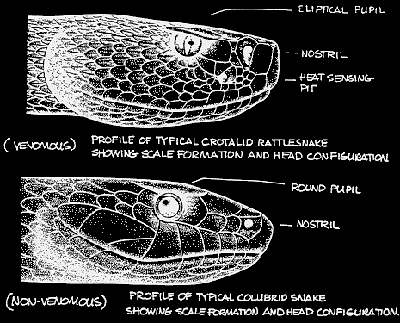
|
|
Spring is the period of greatest activity. Emerging from winter hibernation, they are hungry and looking for mates, as this is also the breeding season. During this time they will eat enormously, look for females to court, and will battle competing males. During these times of stress, and when trying to eat and when in their opaque stage several days before they are ready to shed, they are most likely to act in an aggressive manner when disturbed. Snakes migrate to and from their winter denning site, so many of them may be found during a short period of time during the spring and fall. Dens are usually in rocky outcroppings in the hills, or in deep animal burrows. According to Ramirez Rattlesnake Removal, who removes 400-600 rattlesnakes a year in Northern California, dens can consist of several hundreds of snakes. It is mistakenly believed that rattlers are active only during the heat of the day. Not only do they rest during the heat of the day, sheltered from the sun, they are adept hunters in the dark, their heat pits and sense of smell guiding them to prey. During periods of excessive heat during the day, many diurnal animals become active at dawn and dusk or partially nocturnal. Thus rattlers are more nocturnal in summer than during the spring or fall, and adults are more nocturnal than juveniles. When out walking, hiking or camping, precautions should be taken from early morning to late evening, as temperature, season and humidity can all affect just when rattlers will be active. Despite their need for heat to be able to function, rattlers can function at surprisingly cold temperatures - especially the Mojave rattlers and sidewinders. Rattlers cannot move fast enough to overtake a person who wants to get out of its way. The only danger is that the person falls or trips in getting away, thus disturbing another snake, or falls towards the rattler rather than away. They are not good tree climbers, but many are good swimmers. Rattlers' preferred habitats include (depending upon species) deserts, grassy plains, and brushy and rocky hills. In addition, there needs to be a suitable amount of prey, proper climate for the species, and places to hide and hibernate. | |
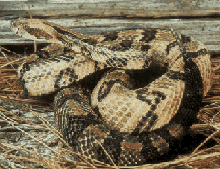
|
Rattlesnake Statistics
|
|
Rattlers' main prey is small mammals. Those that live near areas with large populations of amphibians will also feed extensively on them. Others will feed on the eggs of ground nesting birds. The amount of venom injected into a bite is variable depending upon a number of factors - the age of the snake and how it perceives the threat; whether or not the snake has just envenomated prey, etc. Mortality rates in the 1950's remain pretty much the same today - only 3% of bites are fatal, and the fatality generally is caused by secondary infection, alcohol poisoning, being bitten repeatedly and/or by multiple snakes, allergic reaction to the venom or antivenin. | |
| Rattles When a rattlesnake is born it has a small rounded tip on his tail known as the pre button. Several days after his birth he will shed his skin for the first time and lose this pre button which the button will replace. This is the first segment of his rattle. But it takes at least two rattle segments to produce any noise. He will gain this ability with his next skin shedding. Thereafter throughout his life he will add a rattle segment with each shedding. It is unusual to find more than eight or nine segments on a wild caught rattlesnake because of the wear and breakage of the terminal segment(s). |
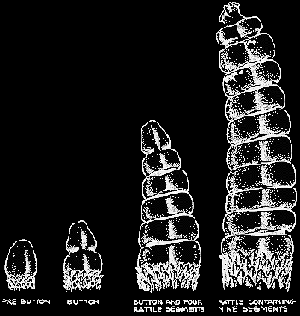
|
|
Fangs When not in use a pit viper's fangs lie folded back against the roof of the snake's mouth. Each resting in a sheath of soft membranous skin. When the moment arrives the maxillary bones rotate the fangs forward. The venom ducts that lead from the venom glands empty into the sheaths. The venom is forced into the opening at the top of each fang and is squirted out of the orifice near the tip. Nature has given the pit vipers an unlimited supply of fangs. Concealed in the roof of their mouth behind each maxillary bone is a series of replacement fangs in progressive stages of development. Throughout the snake's life there is a never-ending cycle of fangs being created, growing and moving forward. Each one eventually to become the functional fang of the moment. This shedding of an old fang and replacement with a new fang takes place approximately every sixty days or so. Each functional fang is stabilized in position by its attachment to the maxillary bone. Each maxillary bone has two sockets for receiving and holding fangs. Normally only one fang is glued in position, but when a new fang is moving into its socket it is not unusual to find the old fang remaining alongside the new one for several days until it is securely locked in place. Rattlesnake Venom and Bite The venomous bite of a Rattlesnake is a tool for hunting and killing their prey. The venom not only kills their prey but also begins the digestive process by breaking down the tissue with hemotoxic components. The hollow fangs of a rattlesnake unfold from the roof of the snake's mouth when it strikes its victim. The venom is injected through the fangs which puncture the victim's skin. This advanced method of venom injection is common characteristic of all members of the Pit Viper family. Rattlesnakes only hunt for prey which they can swallow whole, such as small squirrels, rabbits, and other small rodents. Therefore, they will not intentionally hunt and strike a large animal, including humans, unless they feel threatened. The elements of most rattlesnake bites are hemotoxic, which damages tissue and effects the circulatory system by destroying blood cells, skin tissues and causing internal hemorrhaging. Rattlesnake venom also contains neurotoxic components which immobilize the nervous system affecting the victim's breathing, sometimes stopping it. Most Rattlesnakes have venom composed primarily of hemotoxic properties. Baby rattlesnakes and the Mojave Rattler are the exception; they have venom which contains more neurotoxic properties than hemotoxic which makes them very dangerous. 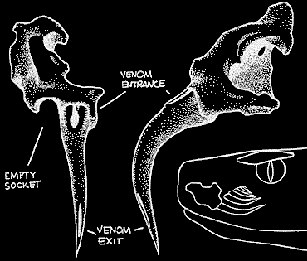
History of Snakebite Treatments Antivenin Crotalidae Polyvalent (Wyeth-Ayerst Laboratories, Inc.) was the first modern snakebite treatment. It was manufactured from horse serum and contained protective substances capable of neutralizing the toxic effects of venoms of crotalids (pit vipers) including rattlesnakes, copperhead and cottonmouth moccasins. It was available beginning in the early 1950's. Side effects of the treatment included fever and rash; additionally, it could cause severe and sometimes fatal allergic reactions in humans. In May 2001, Wyeth-Ayerst Laboratories announced that they expected to be sold out of their Antivenin for at least the months of May and June. This is the second year in a row that Wyeth has experienced production shortfalls. In the Summer of 2000 there were also widespread shortages of their Antivenin. Unfortunately, at the time, it was the only treatment available. In October 2000, the first new snakebite treatment in 50 years was approved. CroFab™ (Altana Inc.) is indicated for the management of patients with minimal or moderate North American crotalid envenomation. CroFab was developed from sheep serum. Side effects of CroFab include rash, urticaria and pruritis (allergic reactions). The administration of an antivenin should be initiated as soon as possible (within six hours) after poisonous snakebites in patients who develop signs of progressive envenomation, i.e. worsening of local injury, coagulation abnormality, or systemic signs of envenomation. 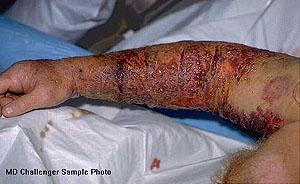
| |
Methods Most of my search for snakebite information was via the telephone. The internet was a great resource of general information about rattlesnakes and their behavior but I didn't discover any detailed information that I needed to complete real GIS research. The trauma centers that serve the three counties for rattlesnake bites (Sierra Nevada Memorial Hospital in Grass Valley, Sutter Roseville Hospital in Roseville, and Auburn Faith Hospital in Auburn) had the greatest potential to supply the data but were unwilling due to the sensitive nature of patient information. I requested that the sensitive patient information be removed and the rest of the data be released but that request was unfortunately met with a negative response. County public health facilities, Department of Fish and Game, California Poison Control, various emergency services, several local hospitals, UC Davis Research Department, and even Ramirez Rattlesnake Removal were unable to provide any specific rattlesnake data. | |
|
Results Yuba County has experienced a phenomenal increase in building permits in the last year as shown in the chart below. The major portion of the homes are being built in areas that are not prime rattlesnake habitat but are none the less long-standing rural areas. Nevada County and Placer are also experiencing similar growth trends as people leave the Bay Area to settle in that area. Though the evidence for urban sprawl into rural areas can be made, the true potential for human and rattlesnake confrontation remains mere speculation without the supportive data from the trauma centers that minister to the victims of snakebite. For 2003, Auburn Faith Hospital reported 13 snakebites. Sierra Nevada Memorial Hospital reported 9 bites in 2002 and 8 bites in 2003. Sutter Roseville Hospital was unable to give any data. Interestingly enough, Loma Linda University Medical Center in Southern California reported 48 snakebites in 2003 and the use of 500 vials of antivenin for snakebite treatment. One reason for the dramatic difference in total number of snakebites between Northern and Southern California is that Southern California is the home of the aggressive Mojave and Western Pacific Rattlesnake. A second factor is that the desert habitat of these snakes is being inundated with homes escalating the opportunities for snakebite. 
| |
|
Analysis
The intent of this project was to discover if there has been a notable increase in rattlesnake bites in the Northern Sacramento foothills paralleling the increase of home development in prime rattlesnake country and if local trauma centers were preparing to meet the possible need for more antivenin. The project was not successful due to the limited responsiveness of the trauma centers. The trauma centers are the only organizations that I could find that keep any specific data on rattlesnake bites. Because the nature of the information being medical data, the data is unavailable to the public for the sake of patient confidentiality. Though the hospitals did give me last year's total number of rattlesnake bites, without several years worth of totals, spatial locations where the bites occurred, and the total number of vials of antivenin used, no analysis could be made. I will note that great reservation was expressed when I requested the snakebite information. Only when I assured the person I was a student doing a research project was there any openness to give me any information. I was able to find an article from Sutter Amador Hospital on May 5, 2002 stating there was a shortage of antivenin and that the California Poison Control maintains a statewide inventory of which hospitals have antivenin on hand. Unfortunately, every attempt to get information from the California Poison Control was unsuccessful. It is interesting to note that the California Poison Control repeatedly responded that they did not keep any information on rattlesnake bites and referred me to local public health facilities. | |
|
Conclusions Research needs to begin on the impact of the human habitation on rattlesnake territory in the foothills of the Northern Sacramento Valley. With the inherent life-threatening dangers of venomous snakebite and the high cost of medical treatment for rattlesnake bites, more data needs to be recorded and centralized for research. More education needs to be given to those who live in rattlesnake country about the behaviors of the rattlesnake and what preventive measures are needed to minimize snakebite. Rattlesnakes play an important role in the ecosystem by helping to keep rodent and amphibian populations in control. Eradication of the rattlesnake is not the answer but proper management of this species could provide the best solution for both man and snake. | |
References
| |